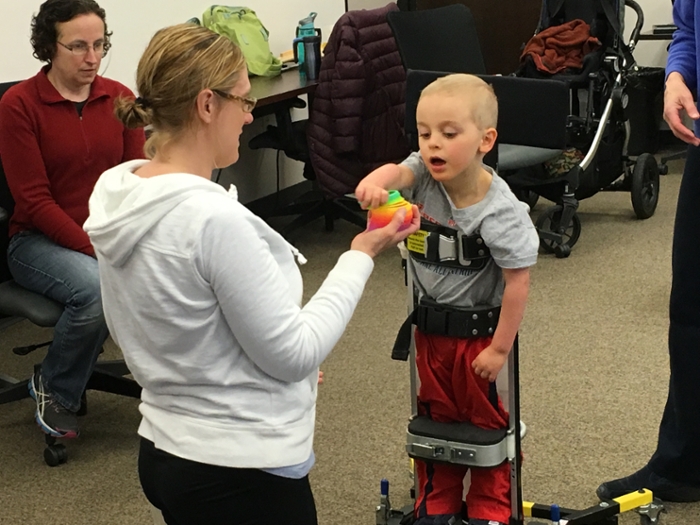Cutting-edge Research by Physical Therapy Professor and Students Improves the Lives of Children with Cerebral Palsy

This story was originally published October 6, 2016.
When five-year-old Brayden Starr was diagnosed with cerebral palsy as a baby, his parents struggled to find ways to give him the best quality of life. There are few treatment options for children with moderate-to-severe cerebral palsy (CP), a brain injury that affects body movement and muscle coordination. When the Starrs met Assistant Professor Sandra Saavedra in the University of Hartford’s College of Education, Nursing and Health Professions, they found a new option. Saavedra is currently the only physical therapist in the United States who offers a treatment that has dramatically improved Brayden’s capabilities. Watch his story:
Brayden, who is unable to walk or talk, was one of the first children enrolled in Saavedra’s study of a treatment known as “Targeted Training.” While typical babies and adults tend to use their spines as one segment the spine is actually made up of several regions. A segmental approach to trunk control works with children with CP and their families so they learn to control the separate spine segments along with their trunk muscles.
“We assess the children’s control by holding them at their shoulders and determining if they can hold their heads,” Saavedra explains. “If they can, we move down under their arms to see if they have control of their upper spines and heads. We progress our hands down the body one region at a time to see if exactly where they have trunk control.”
After the assessment, Saavedra and her team, which includes doctor of physical therapy (DPT) students at the University, send each child home with a device that helps them stand (see photo above). The device is custom fit for each child. It helps them practice controlling their spines and it supports them where needed. Parents and child do therapy at home and are reassessed every two months. Brayden was in the program for 18 months.
“Brayden can now sit up on his own,” says his father, Chris Starr joyfully. “Before, he would just fall over after a few seconds.” Chris and his wife Christina are also grateful that, because he has gained more control of his upper body, Brayden is now able to play with toys and better interact with his friends and family by looking up and smiling.
Saavedra’s ultimate goal is to refine the treatment and the device, which is currently available in the United Kingdom, but not the United States. She then hopes to teach health clinicians to use the segmental approach so that patients across the country can benefit.
“This research transcends beyond just cerebral palsy,” says Molly Maine ’14, a doctoral candidate from Simsbury, Conn. “You can use it on typical children, athletes, or adults with strokes.”
More than a great learning experience, Saavedra’s research also gives her DPT students a competitive advantage when applying for jobs.
“This is a really unique experience. We have had the privilege of working with our advisor Sandy and people in England and other researchers from all over the United States,” says doctoral candidate Lauren Parsanage ’14 of Portsmouth, R.I. In the development of the targeted training exercises, the students and professor Saavedra have worked closely with the experts in England who created this technique and have discussed their ideas with a team of international researchers from Denmark, Hong Kong, and England.